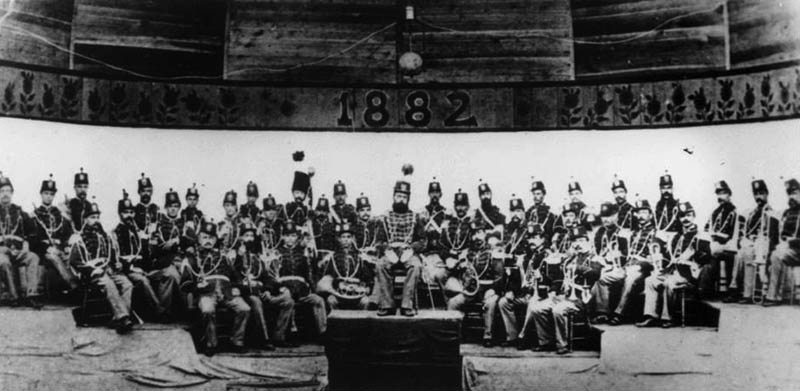
Hail to the Chief: “The President’s Own” Supports the Inauguration
By: Kyle WattsPosted on January 20, 2025
Editor’s note: This story originally ran in the April 2017 issue of Leatherneck Magazine.
On Jan. 20, 2017, Supreme Court Chief Justice John Roberts administered the oath of office to President-elect Donald J. Trump, making him the 45th President of the United States. During this culminating moment of the Inauguration ceremony, cheers and applause filled the air as “Hail to the Chief” greeted President Trump for the first time in his new role. Every four years, this occasion results in in a variety of uniquely American experiences—there is the morning worship service with following procession to the U.S. Capitol, the new President’s inaugural address and later, the parade and evening balls. One tradition pervading the entire day, and enhancing all others, is music.
Music has played a central role in the traditions of Inauguration ceremonies for more than 200 years. Many organizations combine to create the atmosphere, but only one has been doing it from the beginning. “The President’s Own” United States Marine Band, is the oldest active professional music organization in our nation’s history and has played a key role in Inaugurations since the 1800s.
Congress ordered the formation of The United States Marine Band in 1798. Shortly after, the band began performing at White House functions during the administration of John Adams. The band’s Inauguration debut, however, would not come until 1801, when Thomas Jefferson was sworn in as the country’s third President. This being only the fourth ceremony of its type in our nation’s history, many of the current traditions had yet to be developed. There was no parade or ball following the event.
Instead, Jefferson simply took the oath of office inside the Capitol building in front of a crowd that was limited by the size of the room. Jefferson’s inaugural speech marked the end of the occasion. “Hail to the Chief” had not yet been composed, let alone associated with the President. To honor Jefferson as the new Commander in Chief, the Marine Band performed an original piece called “Jefferson’s March,” composed specifically for the ceremony.
As the years passed, the Inauguration ceremony traditions developed and the support provided by the Marine Band evolved. The band quickly became a White House staple, and President Jefferson is credited with christening the band as “The President’s Own.” Jefferson’s second inauguration in 1805 included the first inaugural parade, and following President James Madison’s swearing-in ceremony, the Marine Band performed at the first inaugural ball in March of 1809. The Marine Band adapted and expanded its role supporting the President through every change and each new precedent included in the ceremony. It has faithfully continued that support on every Inauguration Day since 1801.
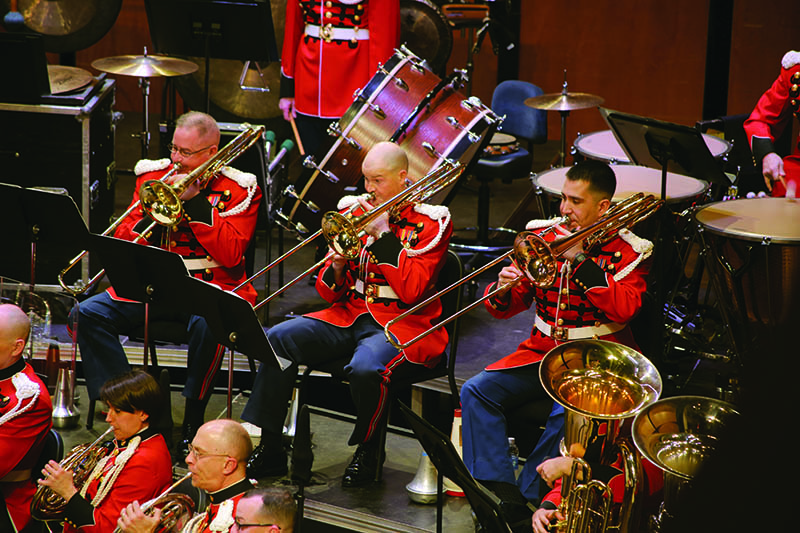
The band’s most fundamental inaugural piece, “Hail to the Chief,” did not appear in the ceremony until President Martin Van Buren’s 1837 Inauguration. At the time, the song had existed for more than 20 years, but it had only been directly connected with the President since 1829. At a ceremony celebrating the laying of the cornerstone of the first lock of the Chesapeake and Ohio Canal, the Marine Band had performed the piece to honor President Andrew Jackson as he departed.
Two first ladies, Julia Tyler and Sarah Childress Polk, are primarily responsible for establishing the tradition of honoring the Commander in Chief with this song. They repeatedly requested that the Marine Band perform the song to announce their husbands’ entrances or as a sign of honor during departures. Over time, the music and the title became inseparable, and the Department of Defense established the song as the official musical tribute to the President in 1954.
Outside of Inauguration ceremonies and White House performances, the Marine Band often supports the President around the nation. “The President’s Own” peformed at the consecration of Gettysburg National Cemetery in advance of Abraham Lincoln’s famous Gettysburg Address. The band led President Grover Cleveland and a parade of 20,000 people through Manhattan to New York harbor for the unveiling of the Statue of Liberty. On Sept. 11, 2002, the Marine Band supported President George W. Bush as he traveled to the Pentagon and ground zero in honor of the first anniversary of the 9/11 terrorist attacks.
Presidential support by the band includes performing in state funerals as well. In 1963 “The President’s Own” led the funeral procession for John F. Kennedy and more recently, the band marched in the procession for Ronald Reagan’s state funeral in 2004.
Musical requirements around the White House take on many different forms. Holiday events such as the annual Easter egg roll, Fourth of July celebrations, and Christmas tree arrival all include performances by the Marine Band. A large, fully staffed detachment of the band performs each time the President officially welcomes a foreign head of state. Garden tours, parties, receptions and many other events all feature music from some varying size element of the band. In all, “The President’s Own” performs upwards of 200 times annually.
Even when not performing in direct support of the President, the band always maintains a full schedule. One of the band’s hallmark traditions is their annual National Concert Tour.
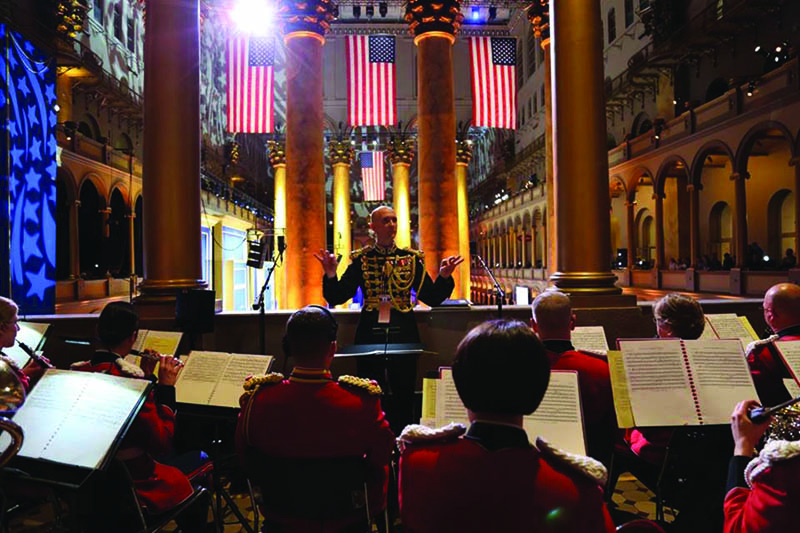
Legendary Marine Band Director John Philip Sousa organized the first concert tour in 1891. As director of the band for more than a decade, Sousa performed with the band in most major cities around the Washington, D.C., area and had previously attempted to organize concert tours that would take them across the nation, but was denied because of the band’s already full schedule supporting the White House. Finally given an audience with President Benjamin Harrison, Sousa later quoted the President as saying, “I have thought it over, and believe the country would rather hear you than see me; so you have my permission to go.”
The 1891 tour took the band to 32 different cities throughout the Northeast and Midwest. The following year, Sousa extended the tour all the way to the West Coast. In the years following 1892, the band conducted their National Concert Tours, with several multi-year gaps. Many successive events factored into this. Sousa’s own departure from the band, and World War I, the Great Depression and World War II all impacted the band’s ability to perform outside the capital. In 1946, the Marine Band resumed the concert tours on an annual basis, and it has held one every year since.
Today, the band’s performances are in such high demand that it cannot tour the entire nation each year. The country is divided into five touring areas, and the band selects a different one each year to visit. The tours last for a month each fall, and concert tickets are free to the public. In 2016, the band went to 30 different cities in 30 days throughout October, traveling through Maryland, Virginia, the Carolinas, Georgia, Alabama and Florida.
Performances at Evening Parades are another central tradition of the Marine Band. Held every Friday night during the summer at Marine Barracks Washington, these are, “a showcase for the ceremonial prowess of Marines and the musical eminence of the U.S. Marine Band.” The band, along with the United States Marine Drum and Bugle Corps and the Silent Drill Platoon, put on an awe-inspiring display in this highly visible and important demonstration of Corps identity.
Despite their busy schedule and wide variety of events, Inauguration Day remains one of the most important events for the Marine Band. It is one of very few performances in which the entire 99-piece band is assembled to march and perform together.
Shortly after the election last November, the band began working with the presidential transition team and the Joint Congressional Committee on Inaugural Ceremonies to determine how the events of inauguration day would proceed. As details gradually were locked in, the band began its marching and music rehearsals. Many parts of the ceremony were known from tradition and precedents set by previous Inauguration ceremonies, but much of the ceremony was specific to this day.
The playing members of the band worked together to perfect the variety of musical pieces being played. Rehearsals were conducted with other musicians or groups participating in the ceremony. Drum Major Master Sergeant Duane King conducted marching drills, perfecting the art of synchronizing all 99 members without verbal commands. The non-playing members had much work to do as well—every musician needed a folder containing copies of the different music being performed, and the music needed to be printed on something that would not blow away in the wind or allow the ink to run in the rain. Every tiny detail of execution needed to be thought through in order to enable the band to perform at its required level.
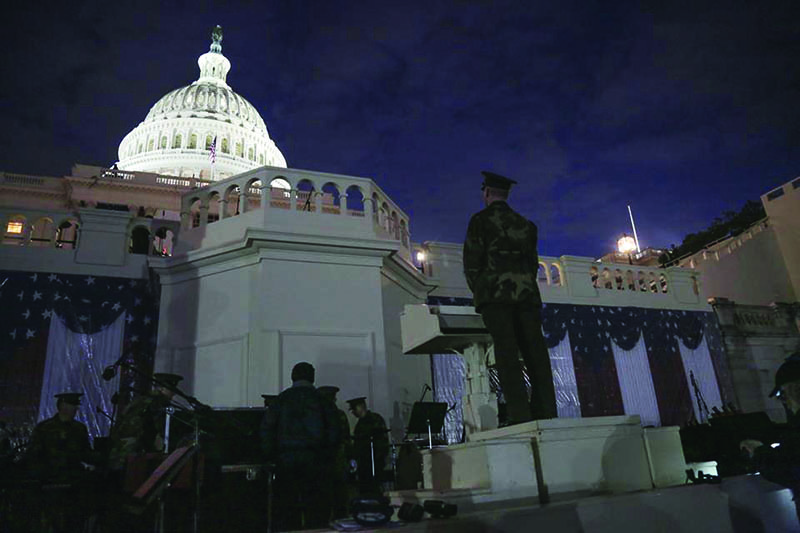
“We have very high expectations for this organization. I expect them to perform at their highest level regardless of the event,” said MSgt King. “There will always be eyes on us, and for many, this is their first glimpse of the Marine Corps and the Marine Band, and we want that to be a great experience.”
A full dress rehearsal was conducted the Sunday before the ceremony. All 152 Marines of the unit had prepared diligently and were ready for the main event to come. “The Inauguration always requires a certain amount of pacing and stamina on the part of the members of the band,” explained Master Gunnery Sergeant Susan Rider, a trumpet player and 20-year veteran of the Marine Band. “I am always so impressed by how the band is able to do its work at the very highest levels no matter what circumstances are presented.” The unit would play a role spanning almost an entire 24-hour period.
Prior to the swearing-in, the Marine Band provided music as a prelude to the ceremony as well as to honor the entrance of dignitaries. The music for this portion of the day was selected by Lieutenant Colonel Jason Fettig, the Marine Band’s director.
“For the entrance of the VIPs, including former Presidents, we try to select titles that have some sort of connection to their background or career,” he said. “Since this is a great American ceremony, I want to try to mirror that in the music that we play.”
Appropriately selected for this prelude were a wide variety of pieces by John Philip Sousa in addition to other classic American tunes such as “National Emblem” by Edwin Eugene Bagley and “Liberty Fanfare” by John Williams.
After the opening remarks and invocation, the ceremony drew to its height at the swearing-in. Vice President-elect Mike Pence took the oath of office and was greeted for the first time with four ruffles and flourishes by the Army Herald Trumpets followed by “Hail Columbia.” The Marine Band plays this song as official honors to the vice president.
The Marine Band followed the vice president’s oath of office with a stirring performance, accompanying the Mormon Tabernacle Choir, of “America, The Beautiful.” This marked the seventh time these two organizations have performed together for a presidential Inauguration. The earliest combined inaugural performance came in 1965 for President Lyndon B. Johnson.
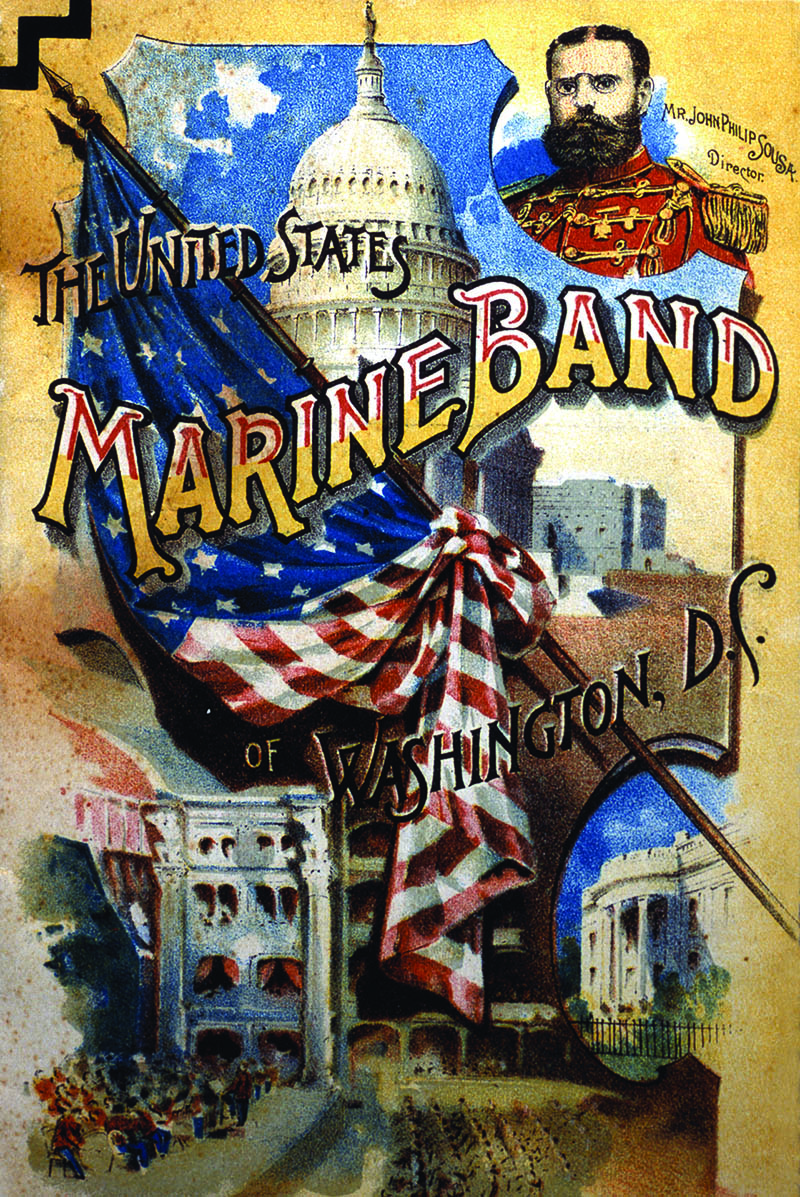
Over the decades, they met again to perform for Ronald Reagan, Richard Nixon, George H.W. Bush, and, most recently in 2001, for George W. Bush.
Next, Chief Justice John Roberts accompanied President-elect Trump to the podium to administer the oath of office. “Hail to the Chief” followed, again preceded by the ruffles and flourishes. To close the ceremony, the Marine Band performed the national anthem, accompanying singer Jackie Evancho.
As the new President attended his inaugural luncheon and made his way to the parade review stand in front of the White House, the Marines were already on the move to the next phase of their day. Immediately following the swearing-in, the band picked up and moved to take their place in the parade.
Formed with their full complement, the band was an impressive site. At the head stood Drum Major MSgt King, adorned in his iconic bearskin headpiece, ornate sash, and Malacca cane mace to silently command the unit. The assistant drum major and five Marine Band officers, including the director, were behind the drum major and the remainder of the band followed, all 99 playing members, arranged in nine columns standing 11 rows deep. As soon as the Marines were formed and the President took his place on the review stand, the parade stepped off. The band performed two Sousa classics, “The Thunderer” and “Semper Fidelis,” on the march from the Capitol to the White House.
As they passed the review stand, “The President’s Own” demonstrated to their new Commander in Chief exactly why they have earned that title. “The parade was quite an experience,” said clarinet player Staff Sergeant Parker Gaims. “I felt the weight of the occasion when the band made its final turn onto Pennsylvania Avenue Northwest, where the presidential reviewing stand was positioned. As we marched up to the stand, I could see the new first family out of the corner of my eye.”
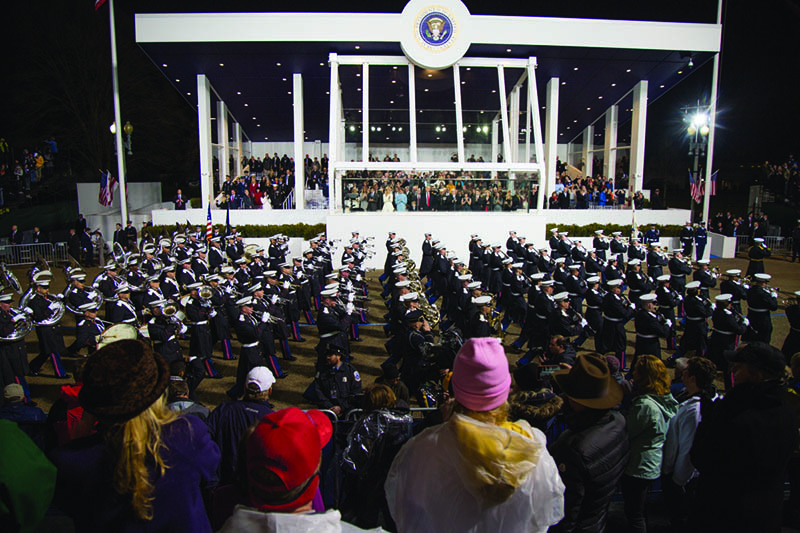
President Trump and the Commandant of the Marine Corps, General Robert B. Neller, watched as the seven non-playing members of the band simultaneously snapped salutes on the Drum Major’s silent command. The playing members performed textbook drill, perfectly covered, aligned and marching in unison, while playing “The Marines’ Hymn.” In this moment, with the world watching, the Marine Band exemplified the professionalism and perfection our nation expects of the Marine Corps.
The band entered part three of their inaugural support following the parade. That evening, the Marine Band performed at the Salute to the Armed Services Ball. Providing music throughout the evening, the band performed a wide variety of Sousa numbers and other popular American pieces.
The Inaugural balls concluded the ceremonies and festivities of the day, but for the Marines, one final performance remained. The band provided musical support for the inaugural prayer service at Washington National Cathedral the next morning. A brass ensemble, conducted by Marine Band Director LtCol Fettig, provided music during the prelude and postlude of the service. During the service, the ensemble accompanied the organ and congregation during the national anthem, “Great is Thy Faithfulness” and “America, The Beautiful.”
Celebration, ceremony and tradition always fill Inauguration Day. “It is important for our country to witness and experience this event together every four years,” said MGySgt Rider. Every four years, Jan. 20 marks a unique and historic experience laid out by the nation’s founders, and the United States Marine Band, occupying their place beneath the ceremony platform, is a special witness to and participant in this history.
“For me, it is a huge honor to take part in the Inauguration Ceremony,” said MSgt King. “It is American history, and to be part of the most American of democratic processes, the peaceful transfer of power, is a very special honor.”
The Marines continued their tradition of excellence on this day, honoring President Trump, the Marine Corps and our nation. Their flawless performance and preservation of American tradition in this 58th Presidential Inauguration demonstrated to the world why they are “The President’s Own.”




